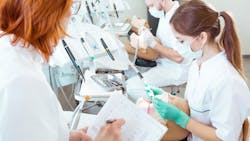Don't sweat the manikin exam: Tips for acing your dental hygiene licensure
The dental hygiene clinical board examination can be a daunting undertaking. But whether you’re taking the Patient Treatment Clinical Examination (PTCE) or the Simulated Patient Treatment Clinical Examination (SPTCE), with the proper preparation and resources, you can ace this exam and be one step closer to becoming a licensed dental hygienist.
After 16 years of practicing clinical dental hygiene, I found myself face to face with the SPTCE to acquire licensure in a new state. To say I was nervous is an understatement. I knew how to remove deposits from a human, but removing deposits from a manikin was something I had yet to perform since the beginning of dental hygiene school.
But I did pass—and with the right resources to prepare you, so can you.
Clinical examination agencies
There are three clinical board examination agencies: Western Regional Examination Board–Commission on Dental Competency Assessments–Council of Interstate Testing Agencies, Inc. (WREB-CDCA-CITA); Central Regional Dental Testing Service (CRDTS); and States Resources for Testing and Assessments (STRA) that offer the PTCE and SPTCE. Not all states accept the SPTCE, so definitely research which examination is accepted by the state in which you will seek licensure.
Each agency has different requirements for passing. For example, WREB-CDCA-CITA consists of two components, the PTCE or the SPTCE and a 100-question Computer Simulated Clinical Examination (CSCE). The CSCE is offered at a testing facility, such as Prometric.
Be prepared
Once you know which examination you must take, carefully review the candidate manual. Exam agencies provide each candidate with a candidate manual that details the exam day, procedures to be completed, and grading. Some testing agencies also offer webinars, question-and-answer sessions, or videos to provide further information for the exam. I can’t stress enough how important it is to READ the manual.
Be punctual
Exam day is not the day to be running late! The manuals for all three agencies suggest arriving a minimum of one hour before your exam time. Arriving early allows you to check in and take a few deep breaths before beginning. If you’re scheduled to take your exam at an unfamiliar location, you should map out the directions or drive over the day before to have a good sense of where you are going.
Don’t be afraid to ask questions
The clinical board examination is a necessary part of acquiring licensure. When you’re reading your candidate manual or watching the orientation videos, jot down any questions. All the testing agencies encourage candidates to email them with questions regarding the clinical exam. On examination day, the testing facility/school will have clinic managers there to answer any questions. Don’t hold back; you’ll never know if you don’t ask!
What to bring to the exam
This is a common question when preparing to take the clinical examination. Although there are obvious things to bring, like instruments, a lab coat, and loupes, you first need some form of identification—without it, you won’t be admitted to the exam. I’ll repeat it: check your candidate manual for what forms of ID are accepted and how many you need. I know that WREB-CDCA-CITA requires two forms, but CRDTS requires only one.
Here are some other items that will benefit you on exam day:
Instruments: I recommend bringing at least two sets of instruments. Both sets should have a calculus detection explorer (ODU 11/12), a probe with 1-mm markings (UNC 12 or 15), and a mirror. Your instruments for calculus removal are your choice. I strongly suggest bringing sharp instruments you are comfortable using.
Lab coat: Although some facilities have disposable gowns, you will likely be comfortable wearing the lab coat you wear daily in the clinic.
Extra personal protective equipment (PPE): I know some facilities dispense PPE; however, if you prefer to wear a particular mask or gloves, I recommend you bring them.
You’ve got this!
You have prepared for this clinical examination since first stepping onto the clinical floor. Treat this day like a typical clinical day, only your patient won’t ask to spit into the suction 100 times or have a large tongue you need to move out of the way. You get to focus on the skills you have learned.
Remember proper instrumentation techniques. Use your explorer with light assessment strokes to detect calculus properly. Ensure you properly adapt, insert, and activate your calculus removal instruments to minimize tissue damage. Tissue damage can cause failure on the SPTCE.
Every facility is different! If your facility allows for mechanical instrumentation, such as a magnetostrictive or piezoelectric, it is best to know if they are available for rent or if you need your own. Last, when probing, remember to keep the probe parallel with the long axis of the tooth with light pressure.
All examinations can be stressful, but with the proper preparation and resources, you can alleviate some of the anxieties and be one step closer to becoming a licensed dental hygienist.
Dental hygiene clinical examination resources
CRDTS 2023 Dental Hygiene Simulated Patient Exam Candidate Manual
SRTA Dental Hygiene Manikin-Based Licensing Examination 2023 Candidate Manual
About the Author
Melissa Calhoun, MSDH, RDH
Melissa Calhoun, MSDH, RDH, has more than two decades of dental expertise. She currently practices clinically in San Diego, California, and has experience in different areas of dental hygiene, including pediatrics. Outside of clinical practice, she is an educator for Arm and Hammer Oral Care and the Swiss Dental Academy (SDA). She teaches National Dental Hygiene Board Examination Reviews with Sanders Board Preparatory. You can contact Melissa at [email protected] or on Instagram @missyrdh.
